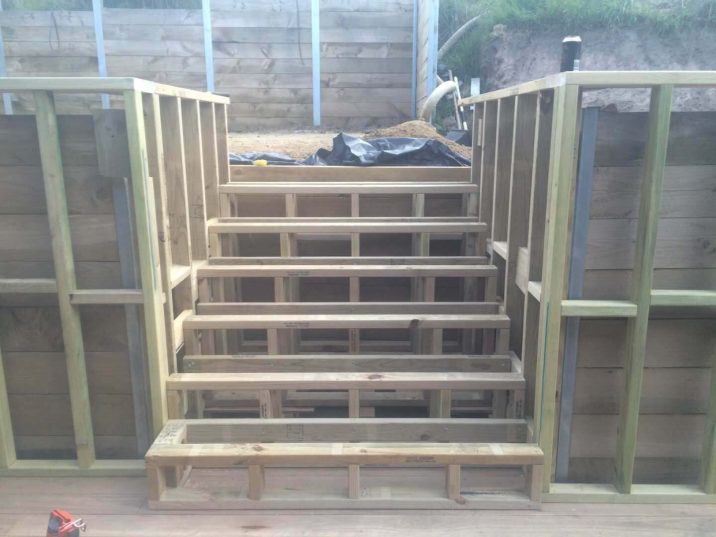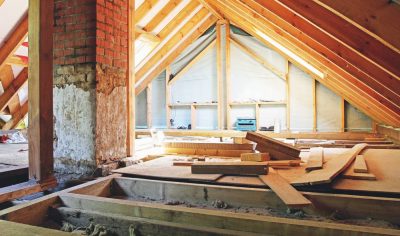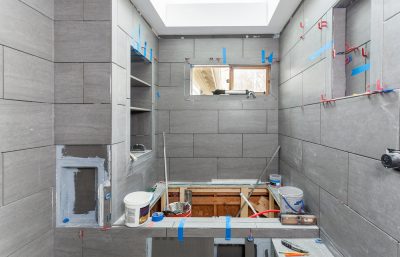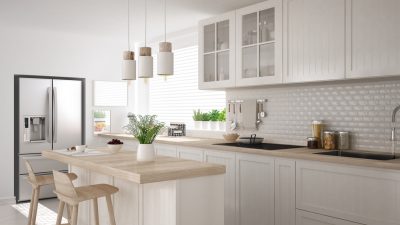- Oneflare /
- Cost Guides /
- Staircase

How much does a Staircase cost?
$1,000 - $4,000
What's on this page
- How much does a staircase cost?
- Staircase cost based on location
- Staircase cost based on materials
- Staircase costs based on style
- Bespoke staircase cost
- Factors that influence staircase costs
- Building regulations and permitting process
- How to save when building a staircase
- Spruce up your place with a new staircase
Read Related Articles
How much does a staircase cost?
If you plan to build or revamp your staircase, you can expect to pay about $4,000. On average, a basic straight staircase might be around $1,000, while a customised design could go up to $30,000 or more.
Many variables can impact the total price, including materials, design considerations, and labour costs. Understanding these cost variations, along with the key components involved in your project, is crucial for effective planning and cost management.
How much do stairs cost based on location?
Staircase design and construction rates in Australia may depend on your location, with slight differences from city to city due to varying average labour rates per state. Here are some average labour costs for building a staircase in Sydney, Melbourne, and Brisbane:
| City | Average Labour Costs |
| Sydney | $30 per hour |
| Melbourne | $30 per hour |
| Brisbane | $35 per hour |
The labour rates for carpenters fluctuate due to factors like cost of living, the professional’s experience, and coverage for overhead costs. Specialised contractors, such as those focusing on specific staircase styles like internal and enclosure stairways, may have higher rates.
How materials can affect interior and exterior staircase costs
The average cost for a wooden interior staircase is approximately $4,000. In contrast, basic exterior or outdoor wooden stairs are significantly less expensive due to the lower cost of exterior-grade lumber. The materials for most basic exterior staircases can be acquired for under $1,000.
Opting for a cheaper material doesn’t necessarily result in a less expensive staircase, as some materials, like stone and glass, require specialised equipment and more labour, making installation more complex. For a breakdown of average staircase costs based on materials, refer to the table below:
| Material of Stairs | Averaged Reported Cost |
| Timber | $4,000 |
| Concrete | $2,000 |
| Metal | $1,000 – $2,000 |
| Glass | $15 – $200 per square metre |
| Marble | $30 – $200 per square metre |
For example, the total cost of a timber staircase depends on the type of wood you choose. With options like pine being the cheapest and native varieties like Tasmanian Oak costing more, the average cost is around $4,200. Despite being pricier, timber is popular for its durability and versatility. For a budget-friendly, customisable, and versatile option, metal staircases are your best choice, ranging from $1,000 to $2,100.
Meanwhile, concrete staircases, starting at $2,000, are known for ease of installation and strength. Glass staircases, costing $15 to $200 per square metre, enhance indoor lighting but can be prone to cracking. For a luxurious choice, opt for marble staircases, which cost around $30 to $200 per square metre. They are durable but have a higher expense and take longer to build.
Staircase costs also differ by style
| Style of Stairs | Average Reported Cost Per Set |
| Straight | $4,000 or less |
| Spiral | $2,000 |
| L-shaped | $2,500 – $3,500 |
| U-shaped | $3,000 – $4,000 |
| Floating | $1,500 – $2,000 |
Different styles of stairs come with varying average reported costs. Straight stairs, known for their simplicity, are budget-friendly, usually priced at $4,000 or less. Spiral stairs, characterised by their compact and helical design, have an average reported cost of $2,000. L-shaped stairs, with a turn or landing, typically range from $2,500 to $3,500.
Meanwhile, U-shaped stairs, forming a complete turn, have an average reported cost ranging from $3,000 to $4,000. Floating stairs, designed with a modern and minimalist appeal, come at an average reported cost of $1,500 to $2,000.
Balustrades and handrails are typically priced separately from stairs unless included in the overall quote. Balustrade materials are commonly sold by the piece or metre and are often costly, while handrails are usually sold by the metre. This separation in pricing emphasises that these components are additional considerations in the overall cost of staircase projects.
How much does it cost to install a bespoke staircase?
Choosing a bespoke staircase crafted from sustainable materials and unique designs may cost $10,000 to $30,000 or more, mainly when created by specialised staircase artisans.
While the investment can be higher, custom-built stairs provide flexibility to adapt to diverse space limitations, such as curves and landings. Beyond functionality, bespoke staircases bring a unique architectural touch to your space, seamlessly fitting into smaller areas or making a statement with dramatic styles in your living or workspace. The designs can even feature intricate cuts and etchings, enhancing the overall character of your preferred style.

The construction phase of a backyard staircase. | Source: chrome projects
How can design and aesthetics impact staircase prices in Australia?
Your staircase isn’t just a visual statement; it reflects your style and the practicality you’re after. In Australia, the average cost of a staircase for a residential design is around $2,500, but this can vary based on materials and design complexity.
Design elements that can influence staircase costs
The fancier the design, the higher the potential cost. Here are some design and aesthetic elements that can affect your staircase project cost.
Handrails
When choosing handrails, consider the materials, their purpose, and compatibility with other elements, as these factors can impact your staircase cost. For example, wooden handrails are popular due to their classic charm, providing old-world elegance. The antique look contrasts strikingly with modern materials like glass and metal, adding warmth and tradition to contemporary designs. These designs can potentially raise your overall project cost.
Balusters
These stair spindles are a big deal for your staircase look and strength. Going custom or intricate, like using exotic wood and personal design, can increase the price.
Materials like iron handrails look good, resist rust, and match any colour scheme. But remember, these special features might raise the cost of your staircase project.
Staircase and railings
When it comes to staircases and railings, materials, design intricacy, and customisation, all play a big role in how much your staircase will cost. For example, choosing an all-metal staircase might cost more, but it’s worth it for its durability and sleek appearance. Its clean design gives off a minimalist vibe, making metal stand out in style and function.
Finishing touches
Refining the details to enhance your home’s look can also raise the overall cost. For instance, adding carpet runners and detailed railings contributes to the overall expense of your staircase project. Although an additional cost, putting a fresh coat of stain or paint on your staircase and stairwell can also be a valuable enhancement for your home.
Other factors impacting staircase installation and construction costs
The cost of building a staircase, whether for residential or commercial purposes, depends on many factors. Know the key considerations that influence the overall cost of installing a staircase:
Number of stairs
More steps between floors mean more labour and materials. Consulting a professional before starting the project is advisable to assess the number and length of the steps, providing a clearer idea of the total cost of building a new staircase.
Types of stairs
Straight stairs, whether with or without a landing, are often the most practical option, costing up to $4000 or less. In contrast, stairs with winder steps or curved and geometric designs, like U-shaped stairs, tend to be more complex and can range from $3000 to $4000.
Local building requirements for balustrades and handrails
Australia’s building code mandates specific requirements for balustrades and handrails, including dimensions of steps, spacing, and handrail positions. These regulations vary by location, so consulting an expert is crucial to confirm compliance with these standards.
Location of the stairs
When remodelling or replacing a staircase, consider that the location of your stairs can influence your expenses. Replacing a main staircase tends to be pricier than in an unfinished basement, as homeowners often opt for higher-quality designs and materials for main staircases.
Project complexity
Choosing a standard, less customised staircase typically results in a lower renovation cost. However, staircases with additional features like handrails, risers, and balustrades incur higher costs.
Size of the staircase
Adhering to size standards is crucial in staircase construction as it directly influences cost, safety, and project duration. According to Australian Standard 1657 – 4.1, stairways should be at least 600 mm wide, with a pitch angle between 26.5 and 45 degrees to avoid classifying as a ladder. Treads must be a minimum of 240mm to meet building code requirements.
Seeking guidance from a skilled contractor is recommended for personalised angle slopes and rise heights.
Labour costs
Home builders typically charge per hour, and the rate can vary based on the tradesmen’s type, skill level, and project complexity.
The demolition of old stairs can cost anywhere from $300 to $1,900. External staircase costs may also vary, and if you need assistance in project management, hiring a general contractor can help oversee the process.
Building regulations and permitting process
Staircases must adhere to safety standards outlined in the Building Code of Australia (BCA) and Australian Standard AS 1657-1992. Key specifications include:
- Risers (vertical steps) and goings (horizontal steps) must maintain uniform heights within a +/- 5mm tolerance.
- Risers should be between 115mm and 190mm in height, while goings must be at least 240mm and no more than 355mm deep.
- The staircase width, measured from the insides of the handrails, should be at least 600mm.
- The pitch angle of a staircase must be at least 25.5 degrees and not exceed 45 degrees. These guidelines ensure the construction of a safe staircase.
The regulations for spiral staircases differ slightly, but the underlying principle remains: a staircase must be safe for use. Ensuring uniform heights between stair treads helps prevent tripping, a reasonable width allows for free passage, and treads must be deep enough to provide a secure standing surface.
According to BCA regulations, a staircase is limited to 18 risers before needing a landing or rest area of at least 750mm square. It’s essential to adhere to these guidelines for improved safety and usability of your new staircase.
Budgeting tips and recommendations for staircase installation
To maintain high standards while managing costs, consider the following tips for saving money in other areas of your project.
Match your design preference with your builder’s expertise
When selecting the ideal staircase for your home, carefully consider the various types available to find the one that best suits your aesthetic preferences and functional needs. Once you’ve identified the preferred type of stairs, ensure that the chosen design aligns with the skillset of your prospective builder.
Determine available space in your home
Start by assessing the available space in your home to determine the most suitable staircase design. Understanding the dimensions and layout of the space will guide your decision-making process. You should also establish a cost range aligned with the available space, ensuring that your staircase fits aesthetically and within your budget.
Find deals on staircase components
You can maximise your savings by actively seeking sales promotions and discounts when shopping for staircase components. Explore clearance sections online and at your local home improvement store to find cost-effective options. By taking advantage of these promotions, you can save money without compromising on the quality of your staircase project.
Know the age of your property
Australian homes exhibit various architectural designs reflecting the historical era in which they were built. Be mindful of your home’s history, as certain designs may be challenging to remodel without compromising structural integrity. For aging staircases in period properties like Victorian, Edwardian, or Georgian styles, focus on preserving original features, performing minor repairs, such as paintwork, and adding accessories to maintain authenticity.
Replace wooden spindles with metal spindles
Elevate your staircase’s appearance with a modern touch by replacing wooden spindles with sleek metal alternatives. This cost-effective update, especially when paired with wooden steps or handrails, can refresh the entire staircase without necessitating a complete renovation.
Hire an experienced staircase builder
When choosing a staircase design company or residential builder, always evaluate their experience and capability to integrate your ideas and preferences. Ensure they provide practical advice on materials and designs, as expert guidance is crucial for a successful staircase installation or construction.
Ready to spruce up your place with a new staircase?
Before starting a staircase project, think about what you need and what you can spend. Costs depend on design, materials, and where you’re putting the stairs. Knowing how these things affect the budget is key to planning well. Whether it’s the type of stairs, labour costs, rules to follow, or materials, each part impacts the total cost.
When you’re good to go, consult a professional staircase installer or builder for a smooth and top-notch project.


